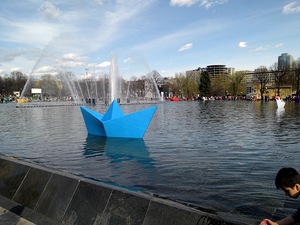ASUS VivoTab ME400CL: Baby with an Atomic Heart
More recently, tablets on Windows are not so different from laptops. The same iron, active cooling, large thickness and short battery life - these were laptops that just removed the keyboard. Windows 7 could not provide convenient control of the tablet, and various add-ons from manufacturers only slowed down the system. Today, when the technical process is reduced, electronic components take up less space, heating is minimal and energy consumption decreases, interesting devices appear on the market that can run on full-fledged Windows adapted for touch input.
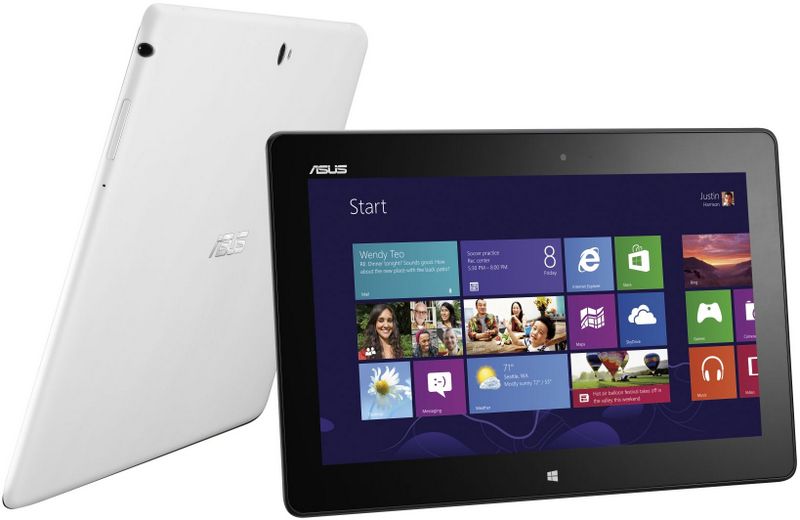
Operating system: Windows 8
Display: 10.1 "Multi-Touch WXGA (1366x768) IPS
Processor: Intel® Atom ™ Z2760 Dual-Core
RAM: 2 GB
Data Storage: 64 GB
Wireless data transmission: WLAN 802.11 b / g / n 2.4GHz, Bluetooth V4.0, 3G, LTE
Camera: front 2 megapixel, main 8 megapixel
Interface: 2-in-1 Audio Jack (headphone / microphone), micro HDMI, Micro USB, Micro SD Card Reader (SDHC)
Sensors: G-Sensor, Light Sensor, Gyroscope, E-compass, Hall sensor, NFC
Battery: 25 Wh lithium polymer battery
Color: white / black / red
Dimensions: 262.5x171x9.7 mm (WxDxH)
Weight: 580 g
Model without 3G - ME400C.
The box in which the tablet is delivered, has the usual ASUS design for all devices: matte cardboard, color printing, showing the device itself and the main characteristics.
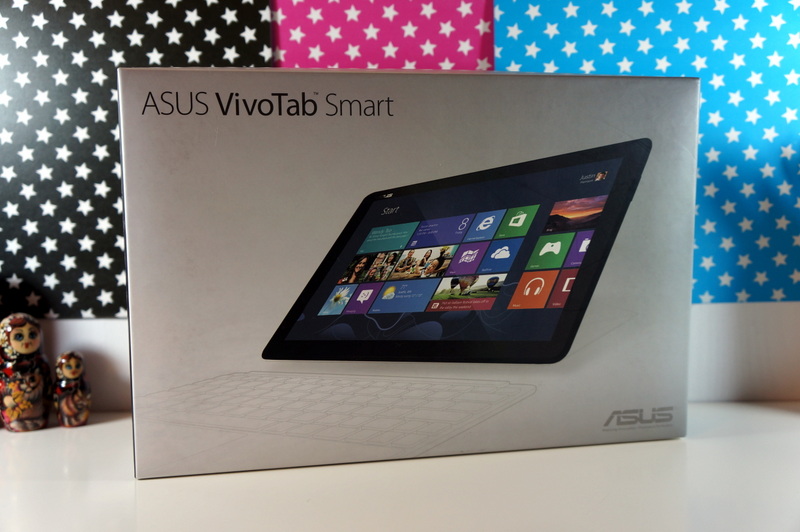

')
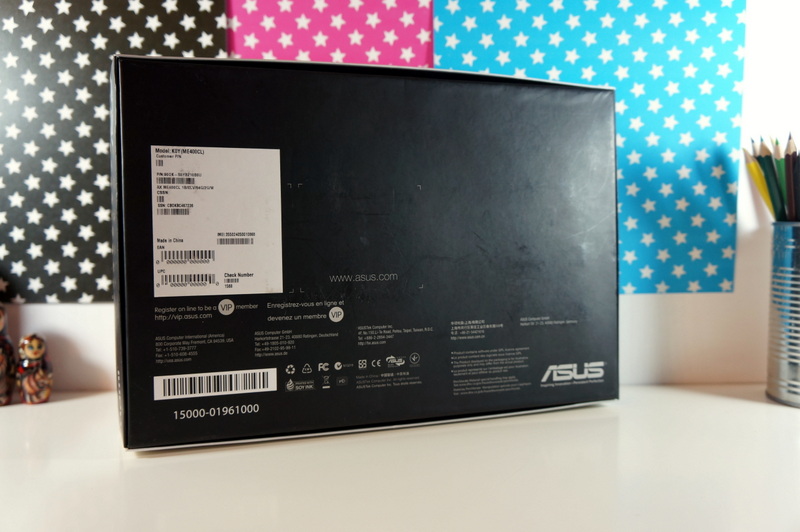
Opening the box, we see that the tablet occupies its entire area.

A sponge is glued to the upper part, which the tablet touches (to avoid damage to the screen). We pull for a film and we take out a tablet from packing.

On the left is a regular USB charger with a small output, about the same size as a smartphone or an ARM tablet, the current is 2 A. Under the tablet lies an envelope with documentation and a microfiber cloth for wiping the screen. In the niche of the usual 90-centimeter cable micro USB.
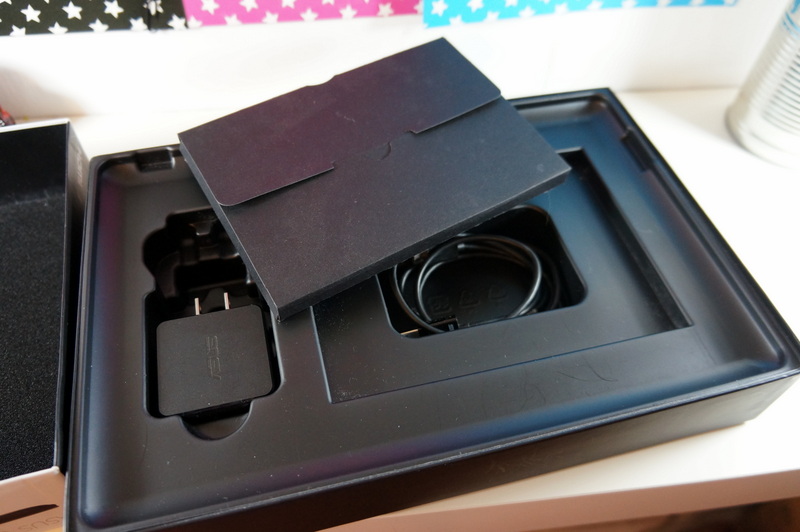
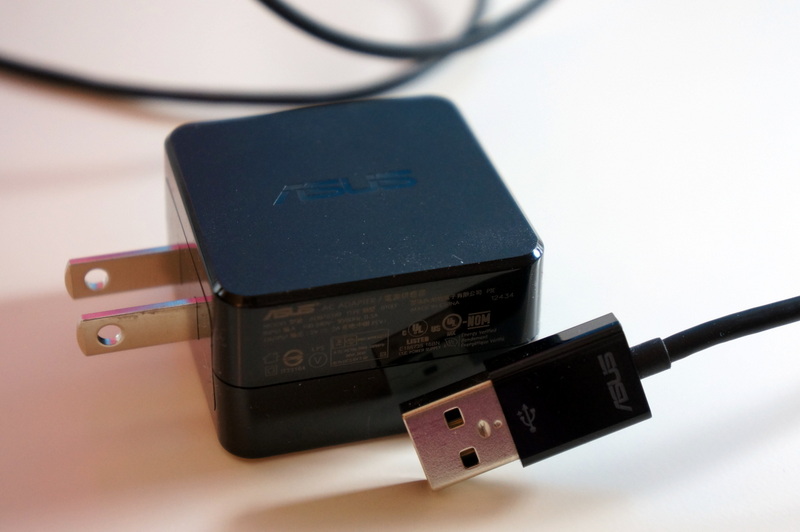
Separately from the tablet, you can buy a protective cover for the Transleeve screen, which can transform into a stand. Transleeve is attached to the tablet with magnets.
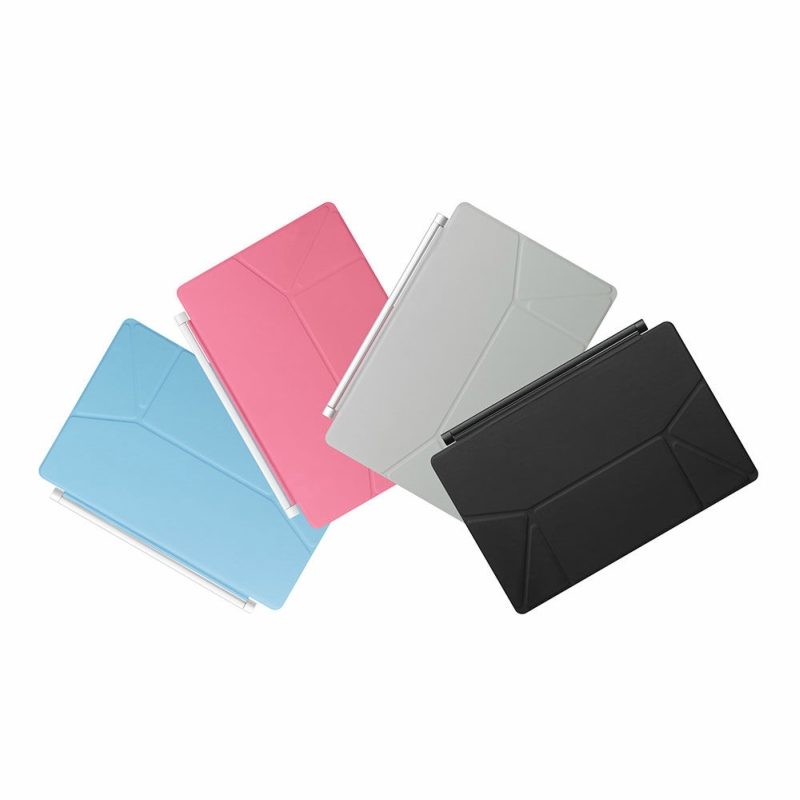
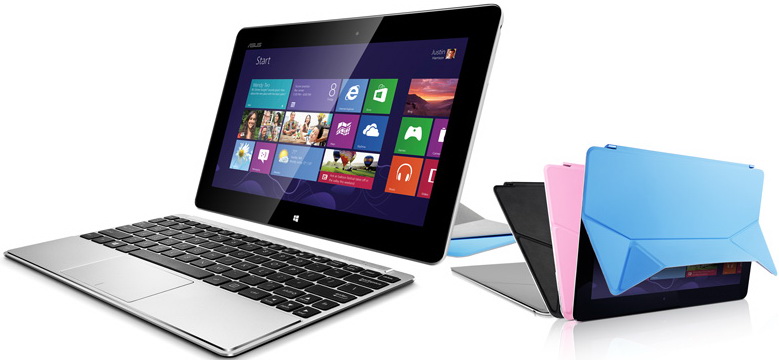
Also on sale is a set with a wireless Bluetooth-keyboard (the same size as the tablet itself) and the cover of Transleeve. Mounts and dock missing. In order to put the tablet on the table, you must use Transleeve. For carrying the keyboard can be attached to the tablet .
Price set - 4.5 thousand rubles .

After reading the reviews on the tablet, I noticed an interesting feature: some users sincerely do not understand why they cannot synchronize the device with the computer. In other words, they do not imagine that they have a full-fledged computer, and in order to copy data to it you must use a flash drive or a network.
The front of the tablet is completely covered with glass. The glass is glued well, does not creak or perforate around the perimeter.
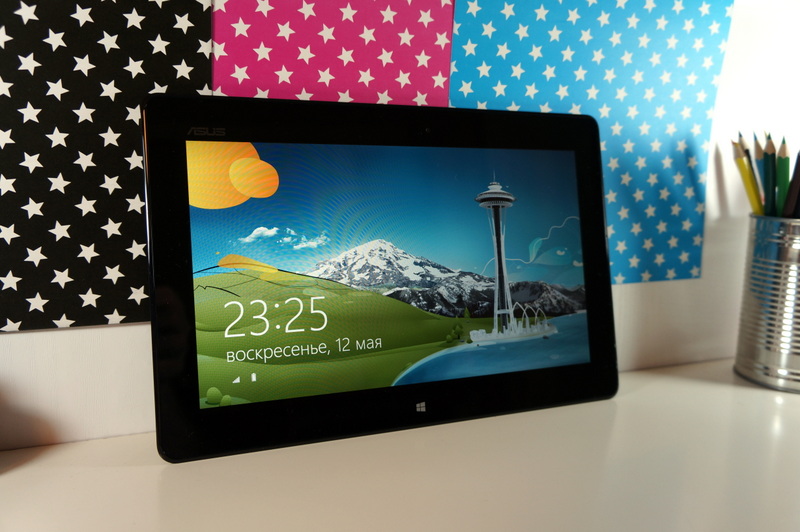
The widescreen screen, respectively, the device case turned out to be elongated and narrow.
In black, the back part is made of matte plastic - something like a soft-touch coating. Fingerprints, of course, remain, but they are not as noticeable as on a glossy surface. On the back there is nothing superfluous, only the ASUS nameplate, a camera and a speaker. Ventilation grille is absent, passive cooling.

It is very unusual to hold a full-fledged computer with such small dimensions. Just a few years ago, my phone was thicker than a modern computer!
Alas, but due to the small thickness of the case on the tablet, a minimum of buttons and interfaces. On the left side are the output for the monitor micro HDMI, micro SD card reader, allowing you to increase the built-in memory by 64 GB. In the 3G version on the left there is a micro SIM card tray, in the lower left corner there is a micro USB connector for charging. This is the miniaturization, all interfaces with the micro prefix.
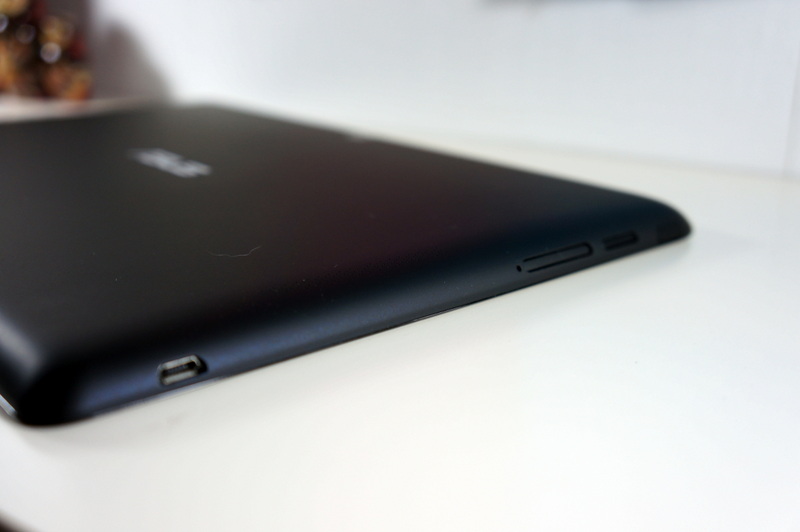
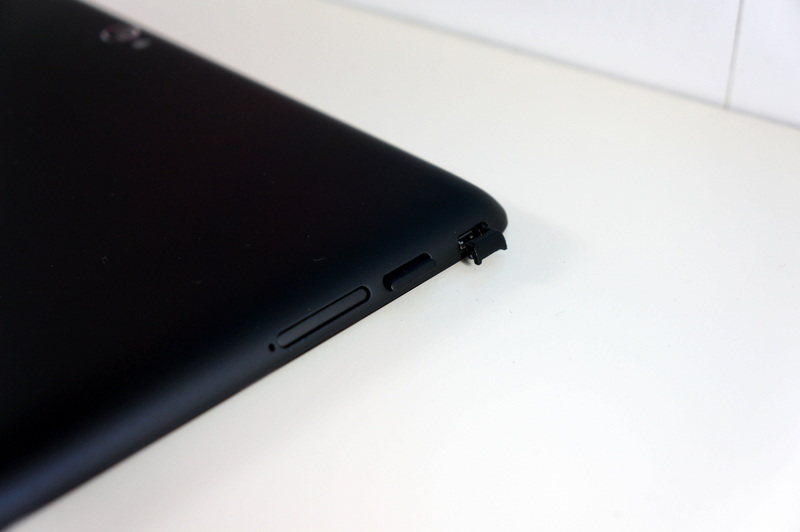
On the right side there is a universal 3.5mm mini-jack for a headset, a volume rocker and a hidden hot reset button.
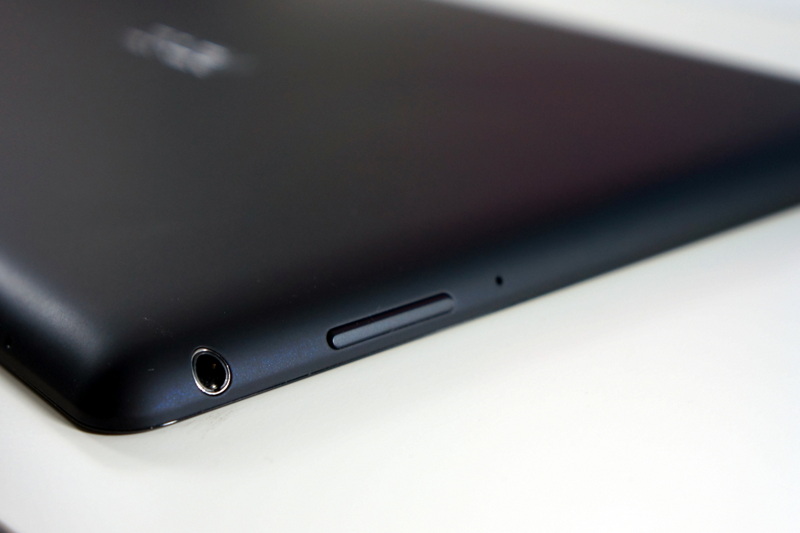
On the top there is a power button and a microphone. On the bottom there is nothing.

The traditional Windows touch button is below the screen.
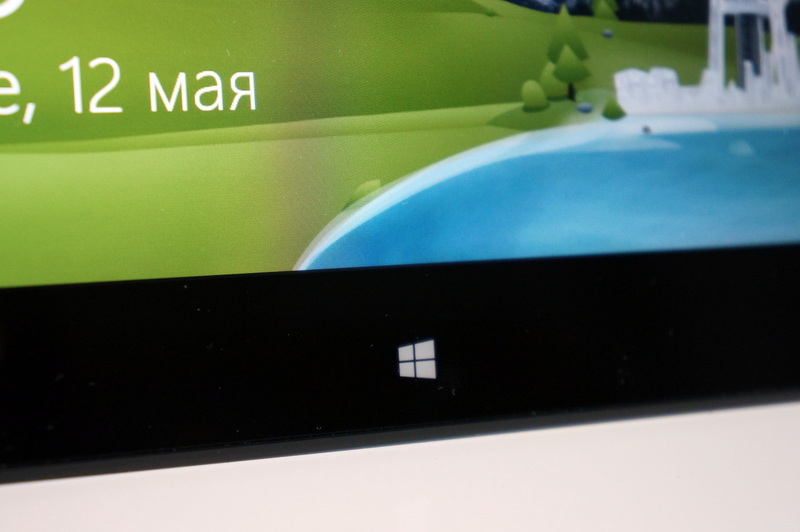
As you can see, there is no space left for a full USB connector. So to connect flash drives and other devices, you will have to buy a separate USB-OTG cord.
The sound component of the tablet has the support of SonicMaster, well-proven in some models of laptops from ASUS. Developed by the ASUS Golden Ear team in collaboration with Bang & Olufsen ICEpower experts , this technology involves the use of hardware and software to improve the sound quality. In my opinion, the speaker is not quite in a good place: we usually hold the tablet by the bottom of the side faces, just blocking the speaker. Despite the fact that the speaker grille is one, two speakers are hidden inside, but of course, there is no talk of stereo sound. The stock volume is large, at maximum volume the sound does not wheeze.

The tablet screen has a resolution of 1366x768 pixels, a diagonal of 10.1 ", the number of pixels per inch is 155.
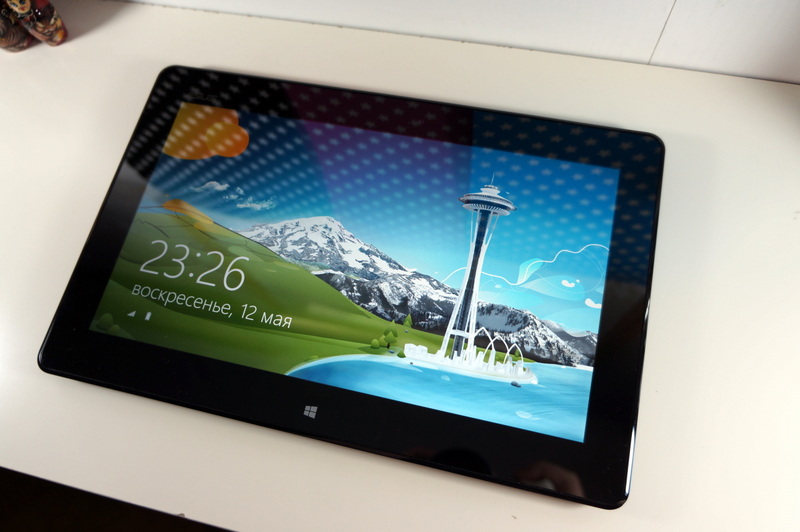
If you do not peer, then the pixels are not visible.
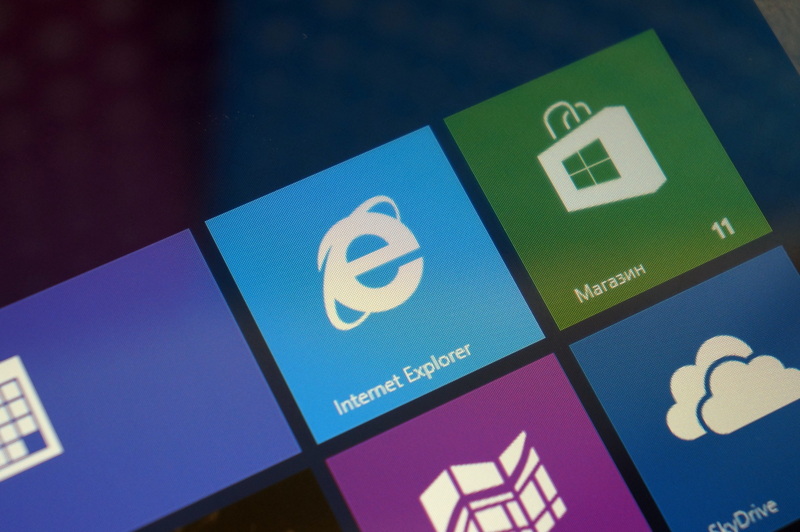

The matrix is made by IPS technology, so that the viewing angles are quite large. Brightness varies from 10 to 320 nits. There is also a light sensor for automatic brightness adjustment. You can disable it in the settings.
The touch screen is made on capacitive technology with MultiTouch support. The screen supports up to ten simultaneous clicks.
Although the screen is small, but in the desktop form it turns out quite well to manage the tablet. I hit the icons, scroll through the lists and quite accurately hit the small buttons. Of course the false positives were, but it was rare and did not cause discomfort.
The front camera for video calls is located above the screen, a 2 megapixel sensor.
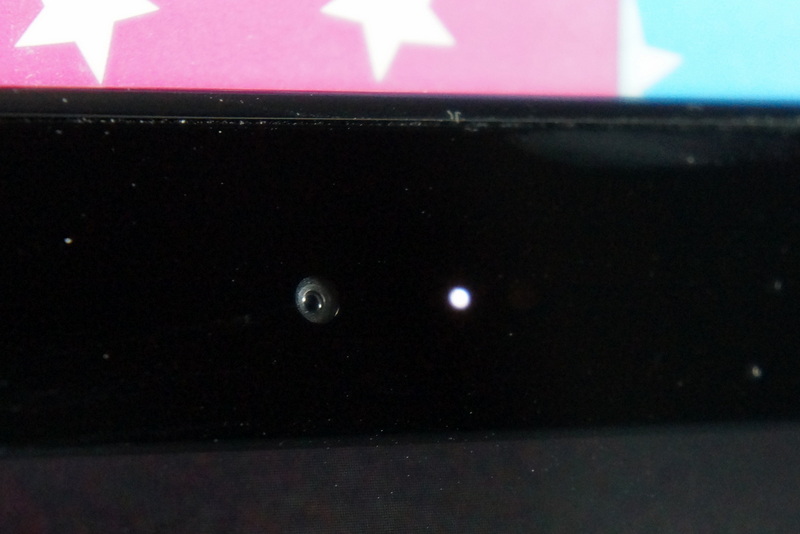
The main camera has an 8 megapixel sensor, autofocus present, f / 2.2 aperture. The camera can record video in high resolution - 1080p. Next to the camera is a LED flash.
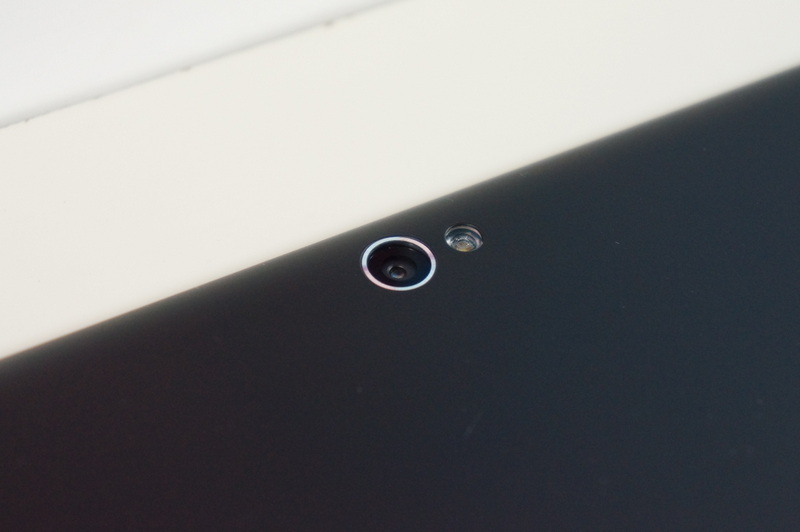
It takes 15 seconds to fully power up the tablet, and 1 second to exit the sleep mode. Inside, there is a dual-core Intel Atom Z2760 processor , made with 32nm process. The main feature of the processor is the lack of active cooling: now the cooler and the warm air will not blow in the tablet. When watching a 720p video, the tablet did not heat up. Having loaded the device with a resource-intensive application, heating occurred in the vicinity of the chamber. Atom Z2760 is able to work with four program threads simultaneously.
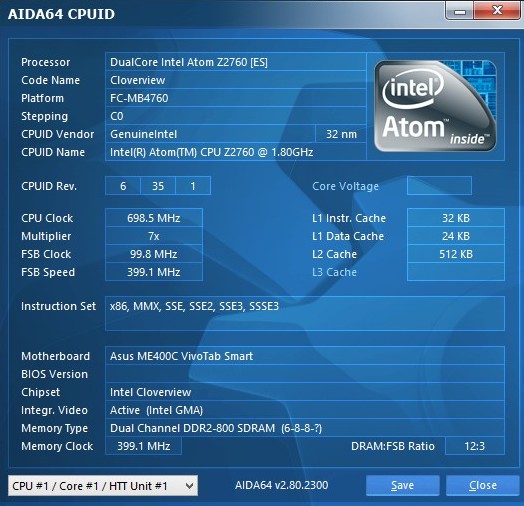
Performance and speed technologies such as Intel Burst Technology and Intel Hyper-threading Technology are supported.



An integrated 32-bit dual-channel memory controller provides support for LPDDR2 memory up to 2 GB with a maximum speed of 800 MT / s.
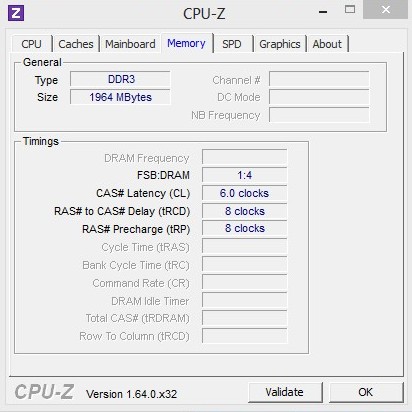
Graphics - Intel PowerVR SGX 545 with a frequency of 533 MHz and hardware accelerated video processing 1080p.
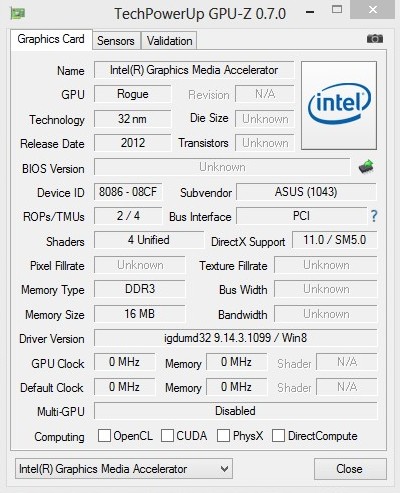
The drive showed low performance. Perhaps because it is a prototype.
SSD speed tests in CrystalDiskMark and HDTunePro.
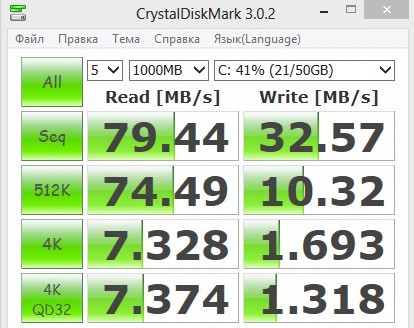

Windows performance evaluation.
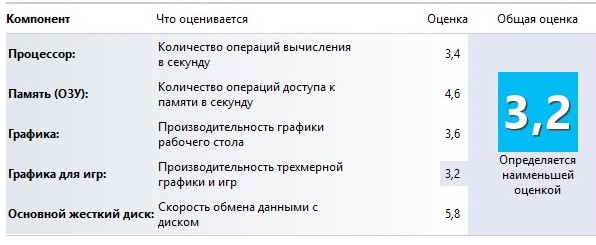
There are accelerometer, compass, gyroscope, light sensor and NFC.
Built-in battery capacity - 25 Wh. The battery is not removable, charging is via the micro USB port. It takes 3 hours to fully charge the device.
Read mode: wireless interfaces disabled, minimum brightness. VivoTab was able to hold out for 10 hours.
Internet surfing: average brightness, Wi-Fi, every 12 seconds a new page opens in the browser. In this mode, the tablet worked for 7 hours.
Video mode: 720p video viewing, wireless interfaces disabled, medium brightness. The tablet worked for 6 hours and 30 minutes.
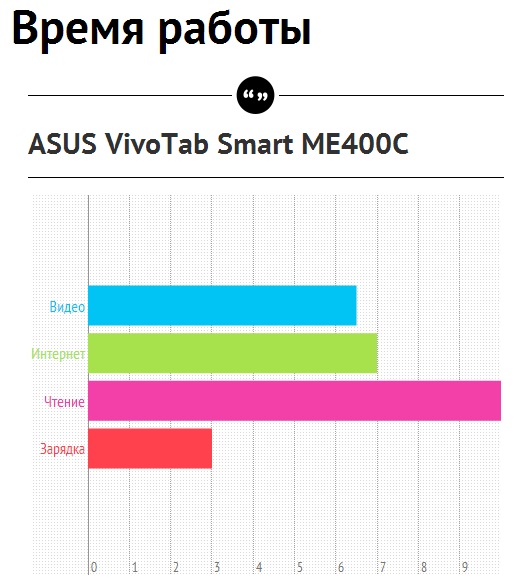
Undoubtedly, ASUS VivoTab Smart will find its buyer among those who need a full-fledged x86-based computer and who would be comfortable to carry with them. We are also pleased that, if desired, you can purchase a USB-OTG cable, keyboard and Transleeve cover, turning the tablet into a universal device with rich functionality. Of course, buying such a tablet, you should understand that there are not so many applications optimized for touch input and the Windows 8 interface. However, on the other hand, you get access to a huge number of applications from the Windows desktop operating system and can use the device as a full-fledged computer.
VivoTab Smart is an excellent replacement for losing popularity of netbooks at a very reasonable price (from 19 thousand rubles).

 Specifications
Specifications
Operating system: Windows 8
Display: 10.1 "Multi-Touch WXGA (1366x768) IPS
Processor: Intel® Atom ™ Z2760 Dual-Core
RAM: 2 GB
Data Storage: 64 GB
Wireless data transmission: WLAN 802.11 b / g / n 2.4GHz, Bluetooth V4.0, 3G, LTE
Camera: front 2 megapixel, main 8 megapixel
Interface: 2-in-1 Audio Jack (headphone / microphone), micro HDMI, Micro USB, Micro SD Card Reader (SDHC)
Sensors: G-Sensor, Light Sensor, Gyroscope, E-compass, Hall sensor, NFC
Battery: 25 Wh lithium polymer battery
Color: white / black / red
Dimensions: 262.5x171x9.7 mm (WxDxH)
Weight: 580 g
Model without 3G - ME400C.
 Package and package
Package and package
The box in which the tablet is delivered, has the usual ASUS design for all devices: matte cardboard, color printing, showing the device itself and the main characteristics.


')

Opening the box, we see that the tablet occupies its entire area.

A sponge is glued to the upper part, which the tablet touches (to avoid damage to the screen). We pull for a film and we take out a tablet from packing.

On the left is a regular USB charger with a small output, about the same size as a smartphone or an ARM tablet, the current is 2 A. Under the tablet lies an envelope with documentation and a microfiber cloth for wiping the screen. In the niche of the usual 90-centimeter cable micro USB.


Separately from the tablet, you can buy a protective cover for the Transleeve screen, which can transform into a stand. Transleeve is attached to the tablet with magnets.


Also on sale is a set with a wireless Bluetooth-keyboard (the same size as the tablet itself) and the cover of Transleeve. Mounts and dock missing. In order to put the tablet on the table, you must use Transleeve. For carrying the keyboard can be attached to the tablet .
Price set - 4.5 thousand rubles .

After reading the reviews on the tablet, I noticed an interesting feature: some users sincerely do not understand why they cannot synchronize the device with the computer. In other words, they do not imagine that they have a full-fledged computer, and in order to copy data to it you must use a flash drive or a network.
 Appearance
Appearance
The front of the tablet is completely covered with glass. The glass is glued well, does not creak or perforate around the perimeter.

The widescreen screen, respectively, the device case turned out to be elongated and narrow.
In black, the back part is made of matte plastic - something like a soft-touch coating. Fingerprints, of course, remain, but they are not as noticeable as on a glossy surface. On the back there is nothing superfluous, only the ASUS nameplate, a camera and a speaker. Ventilation grille is absent, passive cooling.

It is very unusual to hold a full-fledged computer with such small dimensions. Just a few years ago, my phone was thicker than a modern computer!
 Interfaces
Interfaces
Alas, but due to the small thickness of the case on the tablet, a minimum of buttons and interfaces. On the left side are the output for the monitor micro HDMI, micro SD card reader, allowing you to increase the built-in memory by 64 GB. In the 3G version on the left there is a micro SIM card tray, in the lower left corner there is a micro USB connector for charging. This is the miniaturization, all interfaces with the micro prefix.


On the right side there is a universal 3.5mm mini-jack for a headset, a volume rocker and a hidden hot reset button.

On the top there is a power button and a microphone. On the bottom there is nothing.

The traditional Windows touch button is below the screen.

As you can see, there is no space left for a full USB connector. So to connect flash drives and other devices, you will have to buy a separate USB-OTG cord.
 Sound
Sound
The sound component of the tablet has the support of SonicMaster, well-proven in some models of laptops from ASUS. Developed by the ASUS Golden Ear team in collaboration with Bang & Olufsen ICEpower experts , this technology involves the use of hardware and software to improve the sound quality. In my opinion, the speaker is not quite in a good place: we usually hold the tablet by the bottom of the side faces, just blocking the speaker. Despite the fact that the speaker grille is one, two speakers are hidden inside, but of course, there is no talk of stereo sound. The stock volume is large, at maximum volume the sound does not wheeze.

 Screen
Screen
The tablet screen has a resolution of 1366x768 pixels, a diagonal of 10.1 ", the number of pixels per inch is 155.

If you do not peer, then the pixels are not visible.


The matrix is made by IPS technology, so that the viewing angles are quite large. Brightness varies from 10 to 320 nits. There is also a light sensor for automatic brightness adjustment. You can disable it in the settings.
The touch screen is made on capacitive technology with MultiTouch support. The screen supports up to ten simultaneous clicks.
Although the screen is small, but in the desktop form it turns out quite well to manage the tablet. I hit the icons, scroll through the lists and quite accurately hit the small buttons. Of course the false positives were, but it was rare and did not cause discomfort.
 Cameras
Cameras
The front camera for video calls is located above the screen, a 2 megapixel sensor.

The main camera has an 8 megapixel sensor, autofocus present, f / 2.2 aperture. The camera can record video in high resolution - 1080p. Next to the camera is a LED flash.

 Performance
Performance
It takes 15 seconds to fully power up the tablet, and 1 second to exit the sleep mode. Inside, there is a dual-core Intel Atom Z2760 processor , made with 32nm process. The main feature of the processor is the lack of active cooling: now the cooler and the warm air will not blow in the tablet. When watching a 720p video, the tablet did not heat up. Having loaded the device with a resource-intensive application, heating occurred in the vicinity of the chamber. Atom Z2760 is able to work with four program threads simultaneously.

Performance and speed technologies such as Intel Burst Technology and Intel Hyper-threading Technology are supported.



An integrated 32-bit dual-channel memory controller provides support for LPDDR2 memory up to 2 GB with a maximum speed of 800 MT / s.

Graphics - Intel PowerVR SGX 545 with a frequency of 533 MHz and hardware accelerated video processing 1080p.

The drive showed low performance. Perhaps because it is a prototype.
SSD speed tests in CrystalDiskMark and HDTunePro.


Windows performance evaluation.

There are accelerometer, compass, gyroscope, light sensor and NFC.
 Battery and working time
Battery and working time
Built-in battery capacity - 25 Wh. The battery is not removable, charging is via the micro USB port. It takes 3 hours to fully charge the device.
Read mode: wireless interfaces disabled, minimum brightness. VivoTab was able to hold out for 10 hours.
Internet surfing: average brightness, Wi-Fi, every 12 seconds a new page opens in the browser. In this mode, the tablet worked for 7 hours.
Video mode: 720p video viewing, wireless interfaces disabled, medium brightness. The tablet worked for 6 hours and 30 minutes.

 Conclusion
Conclusion
Undoubtedly, ASUS VivoTab Smart will find its buyer among those who need a full-fledged x86-based computer and who would be comfortable to carry with them. We are also pleased that, if desired, you can purchase a USB-OTG cable, keyboard and Transleeve cover, turning the tablet into a universal device with rich functionality. Of course, buying such a tablet, you should understand that there are not so many applications optimized for touch input and the Windows 8 interface. However, on the other hand, you get access to a huge number of applications from the Windows desktop operating system and can use the device as a full-fledged computer.
VivoTab Smart is an excellent replacement for losing popularity of netbooks at a very reasonable price (from 19 thousand rubles).
Source: https://habr.com/ru/post/179447/
All Articles












